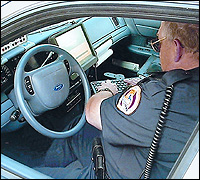CRIME INDEX SETS RECORD
5.6 Million Queries in a Single Day
02/15/06
 |
|
NCIC
performs 4.8 million transactions daily,
24 hours a day, seven days a week.
|
When
a New York City police officer on patrol in
1967 radioed a request to the FBI's new National
Crime Information Center (NCIC) to run the
plates of a suspicious parked car, he learned
in 90 seconds that the car had been stolen
in Boston a month earlier. By any measure
of the day, the transaction-the first to NCIC-was
speedy, considering it had to search 95,000
records in 15 state and city computers linked
to the FBI.
Today,
more than 94,000 law enforcement agency computers
in the U.S. and Canada are linked to NCIC,
a massive index of criminal justice information
that processes about 4.8 million transactions
every day, 24 hours a day, each in a fraction
of a second. Last month, on January 6 alone,
a record 5,623,838 transactions were processed.
The
figure represents a new high-water mark for
one of the FBI's most direct day-to-day contributions
to criminal justice agencies. Every time a
police officer runs a license plate on a traffic
stop, for example, the information is compared
against property files (boats, guns, license
plates, securities, vehicles) and 11 separate
person files that include sex offenders, fugitives,
protection orders, missing or wanted persons,
terrorists, and gang members. If the information
is flagged, officers know who they are dealing
with before even approaching a car at a traffic
stop.
"This
has a direct impact on officers' safety on
the street," said Assistant Director
Thomas E. Bush III, of the CJIS Division.
"It's a pretty large responsibility-it
has to be accurate and it has to be timely."
NCIC
is housed at the FBI's Criminal Justice Information
Services (CJIS) Division facility in Clarksburg,
West Virginia, which is also home to the FBI's
fingerprint database and the National Instant
Criminal Background Check System for potential
gun buyers.
Here's
how the NCIC works: the FBI provides a
host-computer and telecommunication network
linking to other federal agencies and local
jurisdictions. Those jurisdictions, in turn,
operate their own computer systems and plug
in the crime information, providing NCIC access
to virtually all local criminal justice agencies
in the U.S.
Use
of the NCIC index has grown at a steady clip
since its inception 39 years ago. Its first
year saw 2 million transactions. Last year,
NCIC processed over 1.6 billion transactions,
an 18% increase over 2004. Since 2002, the
average number of daily transactions has grown
from about 2.4 million to 4.8 million, while
the turn-around time has shrunk to a mere
.06 seconds.
A
major technological upgrade in 1999 led to
the near-instant results on queries. In 2003,
the index was modified to include files in
the FBI's new Terrorist Screening Center.
On any given day, 700,000 law enforcement
officers have access to NCIC; one in three
transactions is performed by a component of
the Department of Homeland Security.
"Post-9/11,
it has become even more critical to get information
to the officers on the street," Assistant
Director Bush said.
Links:
FBI National
Crime Information Center
Photo
courtesy of Public Roads, January/February
2003, Department of Transportation.


